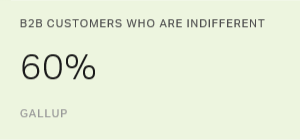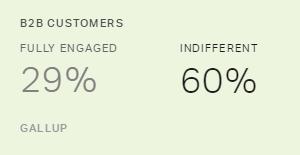Story Highlights
- 71% of B2B customers are indifferent or actively disengaged
- A key driver of organic growth: evaluating opportunities
- Company positioning and approach is another key driver
This article is the second in a two-part series.
According to a Gallup report, 60% of business-to-business (B2B) customers are indifferent and 11% are actively disengaged, while just 29% are fully engaged. This failure to engage customers means that B2B companies will fail to create organic growth -- that is, get more business from existing accounts.
To increase organic growth, B2B companies need to tailor their approach to creating customer impact in their most important accounts.
Gallup has identified four areas that companies and their account teams can focus on to engage customers and deliver impact to existing customers, which ultimately will help generate more organic growth. These key drivers of success include engagement, relationships, opportunities, and positioning and approach. The first article in this series discussed the first two areas; this article addresses the others.
Opportunities
When evaluating the opportunities to create organic growth, B2B companies should ask themselves: "Are there clear and feasible paths to increasing business with our customers?"
The goal of organic growth is to retain and grow business in each account. Yet the avenues for doing so using the key drivers aren't always apparent to B2B companies. Growth may come from selling customers more products or services from existing product lines. B2B companies can achieve this by helping customers expand their business and, therefore, their use of those products -- or by taking market share from competing vendors.
Though desirable, these approaches might not always be viable options. For example, customers could be "maxed out" in particular product categories or comfortable maintaining their existing vendor relationships. And if a B2B company is already a customer's primary vendor, the customer might be hesitant to give the company an even larger share of its business, preferring to maintain a multivendor approach.
Opportunities for growth, therefore, might be found in new product categories or territories, including areas where the company does not currently have a presence or areas that require third-party partnerships or alliances.
B2B companies also can find new opportunities by enhancing their products or services. This approach can offer significant competitive advantages by increasing the chances of building long-term relationships with their key accounts.
Customers, however, might not be as enamored as B2B companies with the improved products or services -- or they might not see the value for the price. If companies put too much pressure on customers to adopt these products or services, customers could feel that the companies are pursuing their agenda ahead of the customers' best interests, which could reduce trust between the two parties.
To avoid these pitfalls, B2B companies must understand their customers' business and strategies to help them find opportunities to expand. This awareness typically comes from executive-level discussions, but account representatives also should have a thorough understanding of their customers' direction. For example, account representatives should be aware of upcoming RFPs or bidding events and the likely expectations or criteria for success in the bidding process.
Whatever the opportunities to increase business with customers, B2B companies' chances of success are limited if there are outstanding problems or tensions in the customer relationship. These issues could stem from previous negotiations that didn't sit well with the customer, recurring quality issues, or other unresolved product or delivery problems.
Positioning and Approach
B2B companies that want to evaluate their positioning and approach should ask themselves: "Are we taking steps to maximize new opportunities with our customers?"
When a customer considers expanding its business with a B2B company, it looks not only at the account representative but also at the account team. The customer wants to know that a company has sufficient technical and support resources to accommodate all of its business -- and that it can readily access those resources.
The customer also wants assurance that a B2B company will aggressively pursue any opportunities that arise within the account. From the customer's perspective, all opportunities should be equally important to the vendor -- but the company might pursue some opportunities over others because they might be more profitable or offer greater strategic advantages.
If a B2B company chooses to pass on an opportunity or is slow to respond to it, it should communicate the reasons to the customer. This conversation could open new opportunities to provide different products, services or types of support -- and keep the customer from questioning the ongoing relationship with the company.




